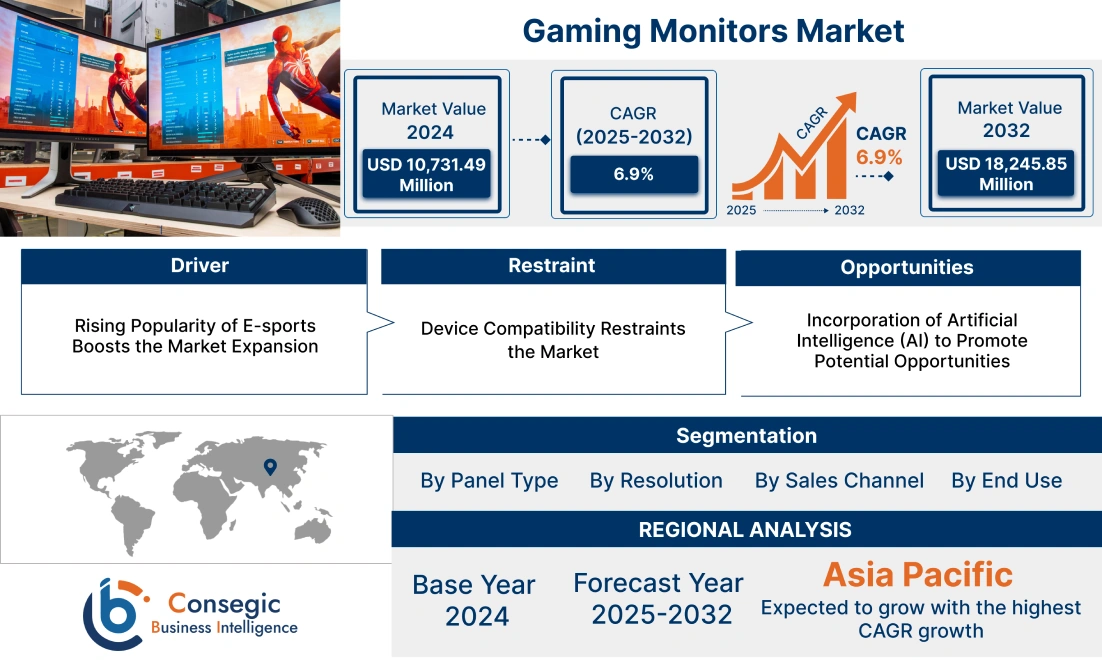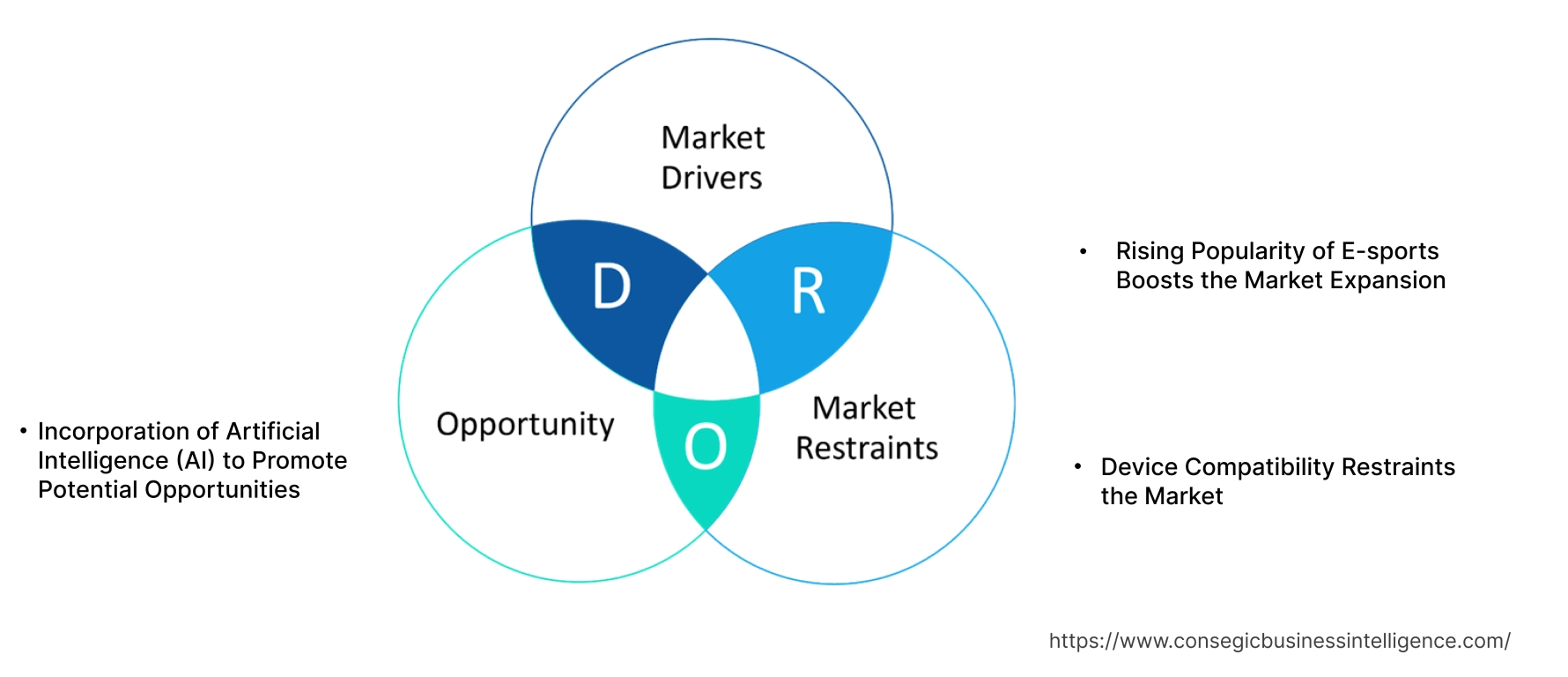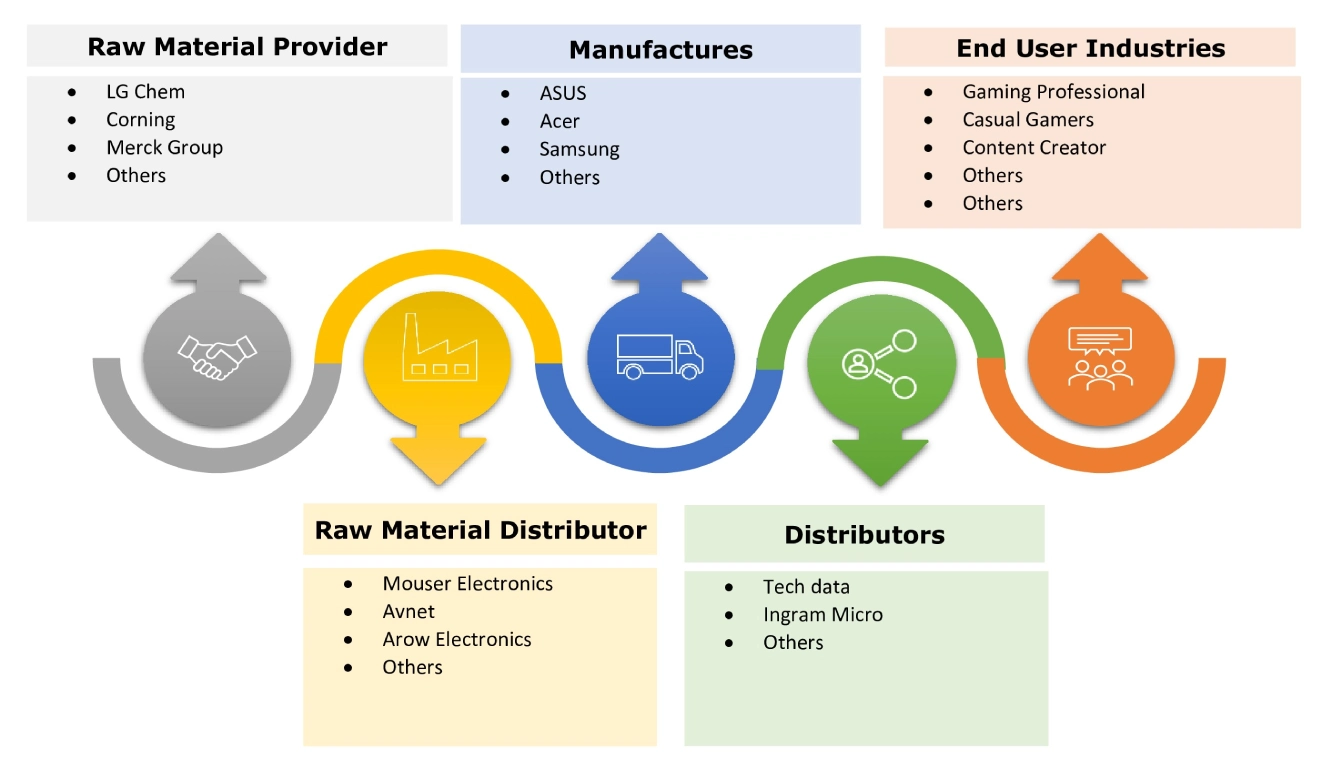Gaming Monitors Market Size:
The Gaming Monitors Market size is estimated to reach over USD 18,245.85 Million by 2032 from a value of USD 10,731.49 Million in 2024 and is projected to grow by USD 11,276.45 Million in 2025, growing at a CAGR of 6.9% from 2025 to 2032.
Gaming Monitors Market Scope & Overview:
Gaming monitors refer to specialized displays specifically designed to enhance the gaming experience by providing high refresh rates, low response times, and adaptive sync technologies. These are built to display games more smoothly and clearly, providing an overall better and more immersive gaming experience. Moreover, they offer a range of benefits including smooth gameplay, quick response, high resolutions, better brightness and contrast, customizable settings, and others. The benefits mentioned above are primary determinants for driving the global gaming monitors market.
Gaming Monitors Market Insights:
Gaming Monitors Market Dynamics - (DRO) :
Key Drivers:
Rising Popularity of E-sports Boosts the Market Expansion
Esports players and competitive gamers require top-notch monitors with qualities such as quick response times, high refresh rates, and minimal input lag to improve gaming accuracy and smoothness. Professional athletes and teams purchase high-quality gaming gear to enhance their performance in practice and competitions, impacting what consumers prefer and shaping market trends. Additionally, the widespread audience of esports tournaments on platforms such as Twitch and YouTube introduces millions of people to the latest gaming technologies, leading to a growing interest in recreating the professional gaming experience remotely.
Furthermore, gaming monitor companies are increasingly collaborating with e-sports teams to develop and promote displays tailored to the needs of competitive players, leveraging their expertise to create optimal gaming solutions
- In January 2024, LG Electronics, (LG) partnered with Gen.G Esports, a prominent esports organization worldwide. Gen.G's professional teams will continue to be provided with LG UltraGear gaming monitors recognized for their fast refresh rates and performance through their ongoing partnership.
Thus, as per analysis the rising popularity of esports is driving the gaming monitors market trend.
Key Restraints :
Device Compatibility Restraints the Market
The lack of technological compatibility is a major limitation in the gaming monitor industry. Utilizing advanced functions like 4K resolution, high refresh rates, and adaptive sync technologies requires expensive and powerful hardware such as high-end GPUs, and capable CPUs. This also requires modern connectivity standards like HDMI 2.1 and DisplayPort 1.4. Individuals using older systems may encounter compatibility problems, which may require expensive upgrades for not only monitors but also graphics cards, power supplies, and cooling systems. Therefore, the technological compatibility associated with the monitors is limiting the gaming monitors market growth.
Future Opportunities :
Incorporation of Artificial Intelligence (AI) to Promote Potential Opportunities
AI technologies enable features including real-time image and color adjustments based on game content, automatic calibration for optimal visual quality, and predictive analytics to improve gaming performance. Additionally, AI-driven smart features could provide personalized settings and recommendations, adaptively learning user preferences over time.
- In June 2024, Samsung Electronics introduced the Odyssey OLED Smart Monitor featuring AI, alongside the Odyssey OLED G8; the Smart Monitor range enhances entertainment features, including the AI-powered Smart Monitor M8; and the ViewFinity series improves connectivity for a comprehensive workstation setup immersive gaming experience with optimal visual quality.
Therefore, the analysis shows rising innovation in AI, integrated with these monitors creates new avenues for the gaming monitors market.
Gaming Monitors Market Segmental Analysis :
By Panel Type:
Based on the panel type, the market is segmented into Twisted Nematic (TN), In-Plane Switching (IPS), Vertical Alignment (VA), and OLED (Organic Light-Emitting Diode).
Trends in the panel type:
- Innovative hybrid panel technologies merging TN, IPS, and VA features are in the works to provide a mix of speed, color precision, and contrast, meeting a wider variety of gaming requirements.
The IPS segment accounted for the largest revenue share in 2024.
- An IPS is a type of LCD (Liquid Crystal Display) monitor and is being used the most in the gaming monitors market.
- Factors including superior color accuracy, wide viewing angles, and vibrant visuals, which appeal to gamers, content creators, and professionals.
- Additionally, IPS panels offer a balance between visual quality and performance, allowing them to be used effectively for a range of gaming genres and multimedia tasks.
- In January 2023, Lenovo ,Legion brand unveiled Legion Y27qf-30, Featuring a QHD resolution and a native refresh rate of 240Hz, the monitor leverages a high-quality 10-bit IPS panel, offering superior color accuracy with 125% sRGB and 95% DCI-P3 coverage.
- Hence, the IPS panel type segment is currently driving the global gaming monitors market share.
The OLED segment is anticipated to register significant CAGR growth during the forecast period.
- OLED monitor is a display technology that uses organic light-emitting diodes to create images.
- They offer excellent image quality with richer blacks, increased contrast ratios, and brighter colors.
- Furthermore, OLED monitors are perfect for gaming and multimedia because of their quicker response times and broader viewing angles.
- Thinner and lighter monitors are achieved by their self-emissive nature eliminating the requirement for a backlight.
- In December 2022, LG Electronics launched UltraGear OLED Gaming Monitors, featuring support for variable refresh rate (VRR), NVIDIA G-SYNC Compatible, FreeSync Premium, and VESA Adaptive Sync for a seamless gaming experience with outstanding contrast, vibrant colors, and high response time.
- Therefore, as per the analysis, OLED panels are expected to become more accessible to a broader consumer base and enhance the gaming experience, resulting in gaming monitors market opportunities.
By Resolution :
Based on resolution the market is segmented into Full HD, QHD, and 4K.
Trends in the resolution:
- Advanced scaling technologies and upscaling features including AI improve the clarity and quality of lower-quality content on high-resolution display.
- Use of multiple monitors with different resolutions is a growing trend among gamers and streamers to have more screen space and boost productivity, by mixing Full HD, QHD, and 4K screens.
The Full HD segment accounted for the largest revenue share of 39.01% in the year 2024.
- Full HD is the most common resolution available in a wide range of these monitors.
- These monitors offer a good balance of visual quality and cost-effectiveness with a higher refresh rate.
- Factors including affordability, wide availability, performance balance, cost-effectiveness, and versatility drive the full HD segment.
- In January 2022, LG Electronics , released the impressive UltraGear gaming monitor, which features a 24.5-inch Full-HD IPS display, delivering exceptional picture quality, a 360Hz refresh rate, and a 1 millisecond Gray-to-Gray response time. The addition of NVIDIA G-SYNC technology enhances LG's new gaming monitor's performance, reducing screen-tearing and improving precision control with NVIDIA Reflex to minimize click-to-display latency.
- Hence, the analysis shows that the Full HD segment is boosting the gaming monitors market demand.
The 4K resolution segment is anticipated to register the fastest CAGR growth during the forecast period.
- 4K monitors offer four times the resolution of Full HD, providing exceptional detail and clarity. This enhances the gaming experience by making textures, environments, and characters appear more realistic and immersive.
- The higher pixel density of 4K monitors creates a more immersive and engaging gaming experience.
- Additionally, Modern GPUs and gaming consoles are increasingly capable of handling 4K resolutions at high frame rates.
- In March 2023, HP Inc introduced a new line-up of OMEN monitors, alongside other gaming hardware and software. These monitors are designed for gamers of all levels, offering high performance, stunning visuals, and enhanced features through the OMEN Gaming Hub to deliver an immersive gaming experience.
- Thus, as per the analysis due to superior visual clarity, advanced graphic technology, and enhanced immersive experience 4K resolution segment is expanding the gaming monitors industry.
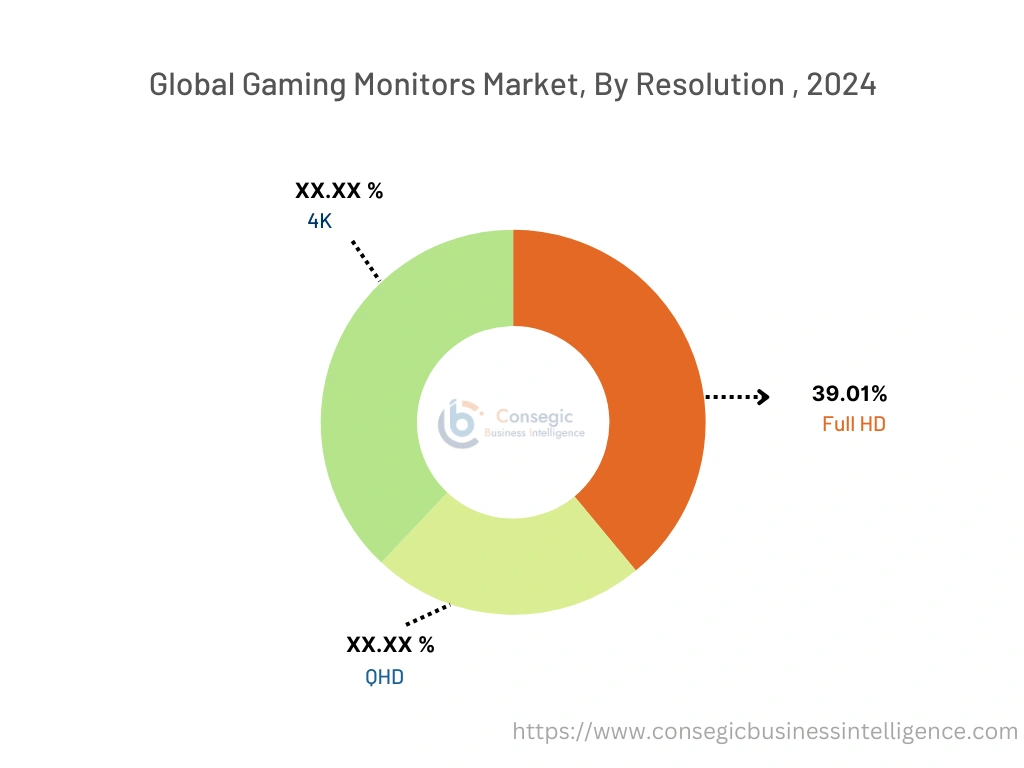
By Sales Channel:
Based on Distribution channels, the market is segregated into online, specialty stores, retail stores, enterprises, and others.
Trends in the sales channel:
- Influencer partnerships and affiliate marketing programs are driving online sales, with gamers turning to trusted personalities for recommendations on the latest accessories .
The online segment accounted for the largest revenue share in the year 2024 and is anticipated to register the fastest CAGR growth during the forecast period
- Online channels offer global accessibility, allowing consumers from various regions to access a broader range of products.
- Factors including convenience and accessibility, price comparisons and discounts, customization, product availability, global reach, and pandemic impact are key aspects driving the expansion of the online segment.
- Moreover, the global e-commerce market is expected to keep expanding, with more consumers preferring the convenience of online shopping.
- Therefore, the analysis shows that these factors suggest the online sales channel will continue to grow and maintain the gaming monitors market demand.
By End-User:
Based on end-use the market is segmented into Gaming Professionals, Casual Gamers, Content Creators, and others.
Trends in the end-user:
- Gaming Monitors are being used to serve multiple purposes beyond gaming, such as content creation, video editing, and general productivity, appealing to users who require versatility in their equipment.
- The casual gaming segment is growing as more people engage in gaming as a hobby. This trend drives demand for affordable yet capable monitors that offer good performance for everyday gaming.
The Gaming Professionals segment accounted for the largest revenue share in 2024 and is anticipated to register the fastest CAGR growth during the forecast period.
- Gaming professionals require monitors with high refresh rates, low response times, and precise color accuracy to enhance their competitive edge and gameplay experience.
- The need for specialized features such as G-Sync, FreeSync, and ultra-high resolutions drives professionals to seek out monitors that meet their exacting standards.
- Factors including high-performance requirements, frequent upgrades, streaming and content creation, e-sports tournaments and competitions, and global reach influence are key aspects driving the growth of the gaming professional segment.
- Additionally, the continuous investment in professional gaming infrastructure partnerships and sponsorships also boosts the segment.
- In June 2024, the Esports World Cup Foundation (EWCF) announced a major partnership with LG UltraGear Gaming Monitors, which will use advanced gaming technology to enhance the global gaming event.
- Thus, as per analysis the increasing popularity of online games necessitates high-performance monitors by gaming professionals, boosting the gaming monitors market expansion.
Regional Analysis:
The regional segment includes North America, Europe, Asia Pacific, the Middle East and Africa, and Latin America.
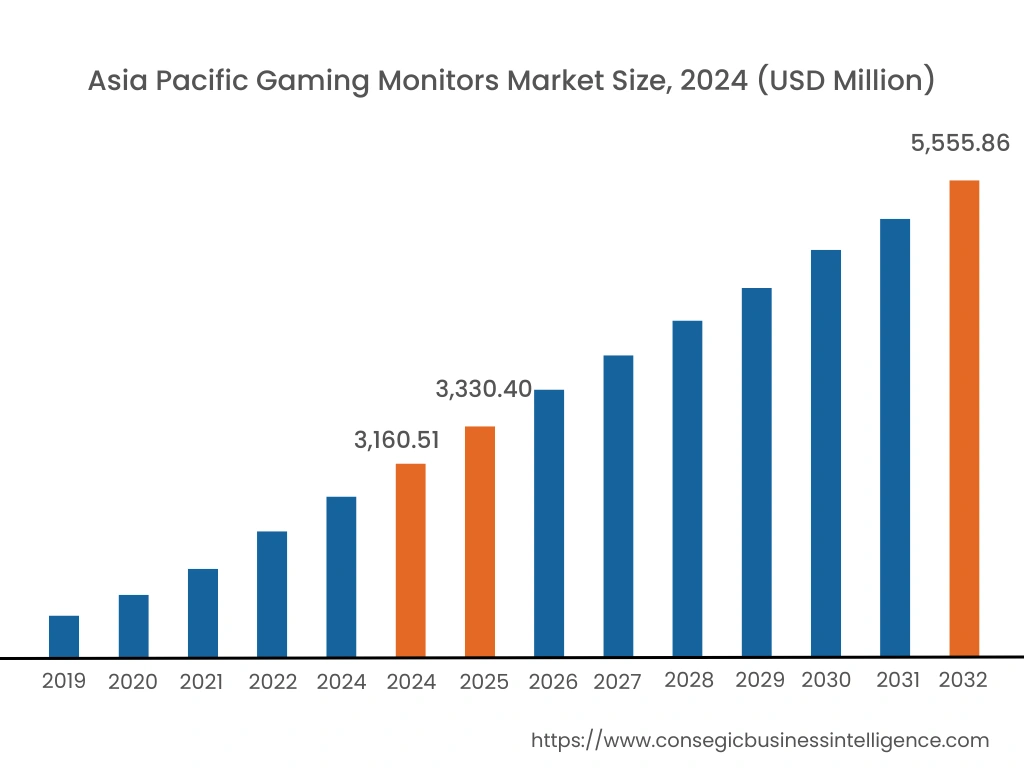
North America is expected to register a CAGR of 6.50% during the forecast period. The gaming monitors market is experiencing robust growth driven by the high adoption rate of advanced gaming technologies and a strong presence of gaming enthusiasts. The region benefits from a well-established gaming culture, including numerous gaming events and a large number of gaming professionals. Major players in the gaming industry, along with significant consumer spending on high-end gaming accessories, contribute to North America's leading market.
- In January 2024, HP Inc. (US) launched the most personalized gaming lineup to date, featuring cutting-edge innovations across its OMEN and HyperX brands. The new range of laptops, accessories, and software is engineered to integrate seamlessly, providing gamers with a unified ecosystem that allows them to concentrate on their gameplay.
Asia-Pacific accounted for the revenue share of USD 3,160.51 Million in 2024 and is expected to reach USD 5,555.86 Million by 2032. In addition, China accounted for the maximum revenue share of 38.6% in 2024.
The demand for a range of gaming monitors is fueled by the region's extensive and varied gamer population, including both affordable and premium options. The increase in e-sports tournaments and gaming cafes, paired with the rising popularity of mobile and PC gaming, is driving the notable expansion of the gaming monitors market in Asia-Pacific. Moreover, the presence of technological advancement and a robust manufacturing sector in the area allows for the presence of cost-effective and cutting-edge monitors.
- In June 2023, Olympic Esports Week, Samsung Electronics (Suwon, South Korea) made a significant impact as a Premium Partner, providing its Galaxy smartphones, tablets, and Odyssey gaming monitors for both esports competitions and public activities.
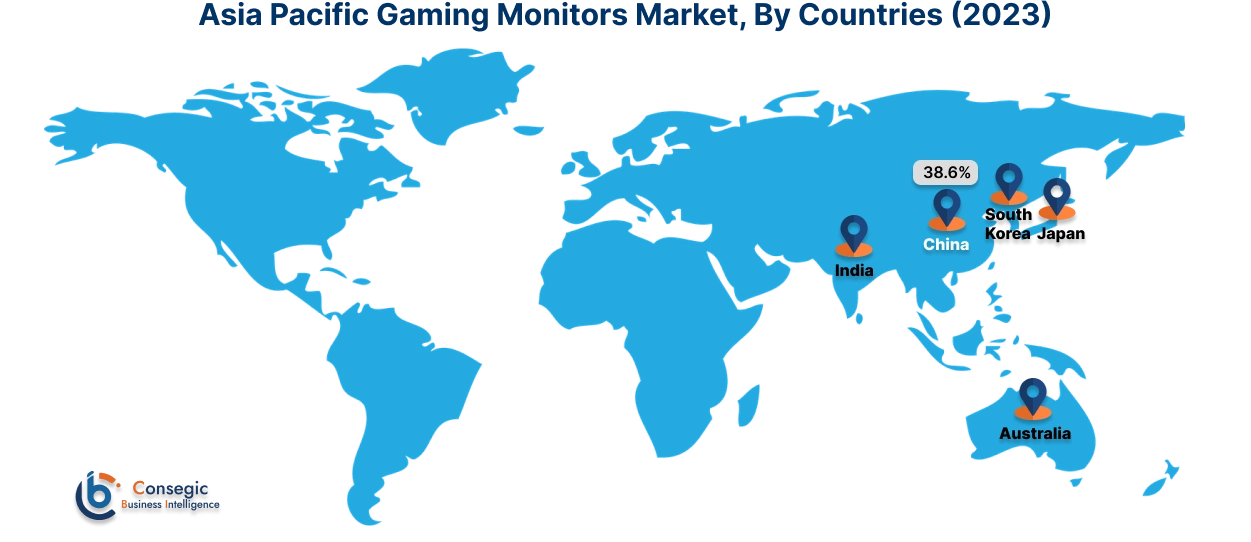
As per gaming monitors market analysis, Europe is experiencing a gradual growth in the gaming monitors market, fueled by rising consumer enthusiasm for gaming and an expanding e-sports community. The different gaming preferences in countries across the region lead to a need for a variety of monitors. Demand for high-resolution and high-refresh-rate displays is on the rise among European consumers looking for monitors that provide better performance and gaming experiences. Major gaming conventions and events in Europe drive the market as gamers and professionals look for cutting-edge technology to remain competitive.
In the Middle East, Africa, and Latin America, the gaming monitors market is poised for growth due to several key factors. The growing interest in gaming and e-sports, along with better internet access and rising disposable incomes, is causing a greater need for advanced gaming technology across Brazil, UAE, Mexico, and others.
Gaming Monitors Market Competitive Landscape:
The gaming monitors market is highly competitive with major players providing enhanced user experience, realism, and immersion to the national and international markets. Key players are adopting several strategies in research and development (R&D), product innovation, and end-user launches to hold a strong position in the gaming monitors market. Key players in the gaming monitors industry include-
Recent Industry Developments :
Business Expansion
- In January 2024, Acer has a Predator gaming monitor lineup with four new premium models designed for immersive gameplay. The flagship Predator Z57 features a 57-inch DUHD (7680x2160) display at 120 Hz, while the Predator X34 V3 offers a popular 34-inch panel. Additionally, the 39-inch Predator X39 and 34-inch Predator X34 X boast bright OLED displays, with refresh rates up to 240 Hz and pixel response times of 0.01 ms for ultra-smooth visuals.
Collaboration
- At CES 2024, ASUS and ROG collaborated to introduce new displays: the 39-inch ROG Swift OLED PG39WCDM, the dual-mode 32-inch PG32UCDP with 4K 240 Hz and FHD 480 Hz options, and the fastest 27-inch OLED monitor, the PG27AQDP. They also introduced the ROG Aura Monitor Light Bar ALB01 and ROG Ergo Monitor Arm AAS01.
- In August 2023, Samsung Electronics announced a partnership with NEXON to launch a gaming monitor featuring the High Dynamic Range (HDR) 10+ GAMING standard created by HDR10+ Technologies LLC offering enhanced visuals with deeper color, contrast, and brightness.
Product Launch
- In June 2023, Samsung , launched Odyssey G9 OLED Gaming Monitors, featuring the cutting-edge Neo Quantum Processor Pro. These monitors boast a DisplayHDR True Black 400 for exceptional contrast and vibrant visuals, coupled with advanced AI upscaling technology.
- In February 2024, LG Electronics introduced the LG MyView Smart Monitor, with Full HD IPS displays, webOS23 streaming platform, and built-in Wi-Fi and Bluetooth, these monitors let you enjoy games, movies, shows, and work tasks without the need for a PC.
Gaming Monitors Market Report Insights :
| Report Attributes | Report Details |
| Study Timeline | 2019-2032 |
| Market Size in 2032 | USD 18,245.85 Million |
| CAGR (2025-2032) | 6.9% |
| By Panel Type |
|
| By Resolution |
|
| By Sales Channel |
|
| By End-User |
|
| By Region |
|
| Key Players |
|
| North America | U.S. Canada Mexico |
| Europe | U.K. Germany France Spain Italy Russia Benelux Rest of Europe |
| APAC | China South Korea Japan India Australia ASEAN Rest of Asia-Pacific |
| Middle East and Africa | GCC Turkey South Africa Rest of MEA |
| LATAM | Brazil Argentina Chile Rest of LATAM |
| Report Coverage |
|
Key Questions Answered in the Report
What is a gaming monitor? +
Gaming Monitors refer to specialized displays specifically designed to enhance the gaming experience by providing high refresh rates, low response times, and adaptive sync technologies. These monitors are built to display games more smoothly and clearly, providing an overall better and more immersive gaming experience.
What is the key market trend? +
Use of multiple monitors with different resolutions is a growing trend among gamers and streamers to have more screen space and boost productivity, by mixing Full HD, QHD, and 4K screens.
Who are the major players in the gaming monitors market? +
Key players in gaming monitors are Acer Inc (Taiwan), Asus (Taiwan), Lenovo (Hong Kong), Dell (US), Samsung Electronics (South Korea), Phillips (Netherlands), HP (US), Alienware (US), AOC (Taiwan), GIGABYTE (Taiwan), LG (South Korea) and others.
